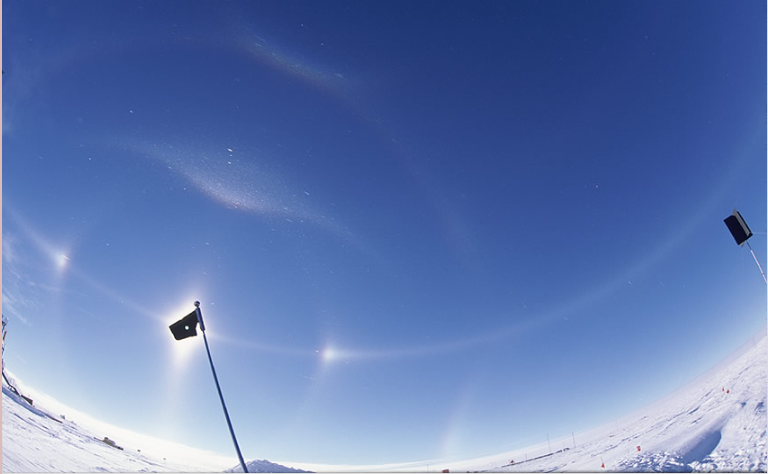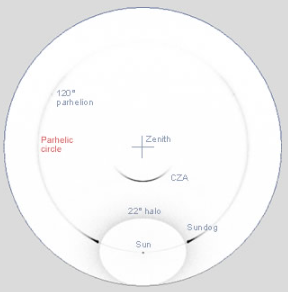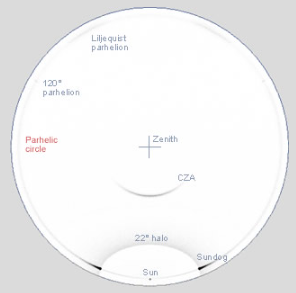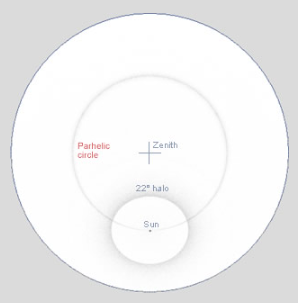Parhelic Circle - Low Sun
Parhelic Circle - Low Sun: A Phenomenon of Atmospheric Optics
Atmospheric optics is a fascinating field that offers a glimpse into the awe-inspiring visual phenomena that occur in our skies. One such phenomenon is the parhelic circle, which becomes particularly intriguing when the sun is low in the sky. In this article, we will delve into the intricacies of the parhelic circle and explore its behavior under different sun angles.
The Parhelic Circle: A Circular Halo around the Horizon
The parhelic circle is a circular halo that sweeps around the horizon, captivating observers with its ethereal beauty. However, it is important to note that this circle is not uniformly bright. Instead, its brightness varies depending on its location relative to the sun and sundogs.
- The parhelic circle appears brighter outside the sundogs, relying on rays that are reflected externally.
- As the circle extends beyond the 120° parhelia, it starts to fade due to less efficient internal reflections.
To better understand the behavior of the parhelic circle, let's explore its appearance under different sun angles.
Very Low Sun: A Subtle Glow
When the sun is only 5° above the horizon, the parhelic circle takes on a subtle glow. However, beyond the 120° parhelia, it brightens once again.
- Notably, two bright regions can be observed around 150 to 160° from the sun, known as Liljequist parhelia. These parhelia were first discovered by Swedish meteorologist G.H. Liljequist in Antarctica.
- The formation of Liljequist parhelia requires almost perfect hexagonal plate crystals and involves two internal reflections. The resulting ray paths exhibit net refraction and a slight coloration.
Higher Sun: A More Uniform Circle
As the sun climbs higher in the sky, reaching a height of 40°, the parhelic circle undergoes a transformation. The rays of light strike the internal vertical faces of ice crystals at more oblique angles, resulting in more efficient reflections. Consequently, the circle becomes more uniform in brightness.
It is important to note that the content presented here has been automatically converted from the old website and may not appear as intended. For the original article, please refer to the link provided.
Conclusion
The parhelic circle is a captivating phenomenon of atmospheric optics that reveals itself when the sun is low in the sky. Its appearance is not only influenced by the sun's angle but also by external and internal reflections within ice crystals. By understanding the behavior of the parhelic circle under different sun angles, we gain a deeper appreciation for the complexities and wonders of our atmosphere. Next time you find yourself gazing at a sunset or sunrise, keep an eye out for the enigmatic parhelic circle and let its ethereal beauty mesmerize you.

Parhelic Circle at the South Pole imaged by Marko Riikonen 11th January 1999 at 0500hrs. The parhelic circle swings through the 22° high sun, brightens outside the sundogs and hugs the flat horizon everywhere at the same height. Image ©Marko Riikonen.

Parhelic Circle for 22° high sun
Sweeping around the horizon, the circle is not uniformly bright. It is fainter through the sun and inside the sundogs where it relies primarily on rays reflected externally.
The halo also becomes faint beyond the 120° parhelia. At these angles, internal reflections become less efficient.
HaloSim ray tracing. Fisheye view centered on the zenith, 40% randomly oriented columns to produce the 22° halo and 60% plate crystals with c/a=0.05.

Very low sun
Here the sun is only 5° above the horizon. Again, the parhelic circle is faint beyond the 120° parhelia - then it brightens again..
The two bright regions 150 to 160° from the sun are Liljequist parhelia first observed in Antarctica by the Swedish meteorologist G.H. Liljequist. Almost perfect hexagonal plate crystals are needed to form them. Their ray paths involve two internal reflections. An example is a ray entering face 3, reflecting off faces 7 then 6 to exit through face 8 (path 3768 see face number key). There is net refraction in this ray path and the Liljequist parhelia are slightly coloured.

40° high sun
Contrast the parhelic circle as the sun climbs higher. The rays strike internal vertical faces more obliquely and are more efficiently reflected. The circle becomes more uniform.
Note: this article has been automatically converted from the old site and may not appear as intended. You can find the original article here.
Reference Atmospheric Optics
If you use any of the definitions, information, or data presented on Atmospheric Optics, please copy the link or reference below to properly credit us as the reference source. Thank you!
-
<a href="https://atoptics.co.uk/blog/parhelic-circle-low-sun/">Parhelic Circle - Low Sun</a>
-
"Parhelic Circle - Low Sun". Atmospheric Optics. Accessed on April 20, 2024. https://atoptics.co.uk/blog/parhelic-circle-low-sun/.
-
"Parhelic Circle - Low Sun". Atmospheric Optics, https://atoptics.co.uk/blog/parhelic-circle-low-sun/. Accessed 20 April, 2024
-
Parhelic Circle - Low Sun. Atmospheric Optics. Retrieved from https://atoptics.co.uk/blog/parhelic-circle-low-sun/.